Capital Projects 2023-2024



Centennial is committed to being a good steward of the public’s funds through the long-range planning of infrastructure improvements. The repair and improvement of the City’s streets, sidewalks, traffic signals and bridges must keep pace with the changing population and ensure the overall utility, efficiency and safety of the City’s infrastructure. The Capital Improvement Program sets the general schedule for public improvements to be designed and constructed. The program as presented in this document is organized into three time frames. The first two years reflect the adopted budget for Fiscal Years 2023 and 2024. The first five years represent a schedule and estimate of future capital needs that may be funded with a reasonable level of certainty. The last five years represent the City’s long-term goals. As the program looks further into the future, the chance of unforeseen events influencing the City’s budget levels and overall priorities increases, therefore the final five years outlined in this document should serve more as guidelines for the City’s decision makers than as a literal schedule for project implementation. The 10-year CIP builds from the project priorities established in the 2040 Transportation Master Plan (adopted in May 2022).
The CIP draws from four sources of funding to implement projects:
• Street Fund
• Capital Improvement Fund
• Open Space Fund
• Conservation Trust Fund
The Street Fund is used to accept revenues from restricted City and State sources as well as transfers from the General Fund, grants and/or developer contributions or other revenues to fund the design and construction of the City’s transportation and safety infrastructure. The following revenues are assigned to the Street Fund: Sales Tax, Motor Vehicle Use Tax, Highway Users Tax Fund, Road and Bridge shareback and pavement degradation fees.
The Capital Improvement Fund is used to fund the major maintenance of all facilities that are owned by the City, such as the Civic Center.
The Open Space Fund and the Conservation Trust Fund work in tandem to fund the maintenance and enhancement of the City’s network of parks, open space and trails. It should be noted that the Open Space Fund is generated by the Arapahoe County Open Space Tax, which restricts how it may be used; the Fund’s availability is contingent on the continuation of the tax as a funding source.
The Conservation Trust Fund is funded by the state lottery program and is also restricted in its uses. This document treats these funding sources separately since, in many cases, resources in a given fund cannot be used to fund proposed projects in another.
The City of Centennial CIP provides four primary functions for the efficient use of funds:
1. Develop a 10-year plan to meet the needs for development of new infrastructure and replacement of existing infrastructure which are funded through taxes, fees, special revenues and supplementary funding sources; all projects within the first two years of the 10year plan are included in the bi-annual budget for 2023 and 2024
2. Provide direction, oversight and quality assurance for the annual implementation of projects in the CIP
3. Respond to citizen comments and questions regarding current and future capital improvement projects
4. Prepare applications for grants and intergovernmental agreements to assist in funding capital improvement projects
Resources to provide the above functions are drawn from both the Public Works and Community Development Departments. The Appendix E of the 2040 TMP includes an allencompassing list of capital projects eligible for funding under the CIP. It is important to note that this list was generated during the development of the 2040 TMP, independent of budgetary considerations. The projects in Appendix E of the TMP are ranked according to their potential benefits. Projects receiving the highest rankings become the building blocks of the 10-Year Constrained List.
The 10-Year Constrained List is a strategic plan for allocating capital improvement funds over the next 10-years. The 10 years covered in this list is divided into three time periods: the adopted 2023 and 2024 budget for capital improvements, medium-term scheduling through 2027 and long-term guidance and recommendations through 2032. The primary considerations in forming this strategic plan are:
• The amount of funds allocated for capital projects in a given year as well as across the entire 10-year span covered by the list; the constrained budget accounts for other funding sources on some projects from grants and other sources such as metropolitan districts
• The impact of the project on public safety and its ability to enhance the lives of the citizens of Centennial
• The impacts of the project to the economic health and longterm viability of the City
• The availability of supplemental funding through grants, intergovernmental cooperation, etc.
Ultimately, this 10-year constrained list provides guidance for future planning.
In November 2018, the City approved Centennial NEXT, the City-wide Comprehensive Plan. The plan promotes quality of life, a sense of community, economic vitality, supporting infrastructure and responsible government that will leave a legacy for future generations. The Centennial NEXT goals and strategies provide direction to turn the plan vision into reality and are found within the plan’s four themes:

• Our NEXT Places
• Our NEXT Economy
• Our NEXT Innovation
• Our NEXT Community
The City of Centennial adopted the 2040 Transportation Master Plan in May 2022. The TMP is based on a set of seven goals that support the transportation needs, community values and the City’s vision. The City’s transportation-focused goals are as follows:
Safety: Transportation-related fatalities and injuries are rare, and people feel safe walking, bicycling, driving, riding public transportation or using a mobility device.
Flexible Mobility: People of all ages, abilities and social identities have convenient and affordable mobility options and freedom of choice to use the travel mode that best meets their needs.
Innovation: Transportation infrastructure and policies prepare for mobility technologies that enhance the user experience and reduce transportation-related emissions and environmental impacts.
Fiscal Responsibility: Transportation infrastructure is designed and maintained to optimize public benefit, and investments leverage funding opportunities and demonstrate good stewardship of public funds.
Efficiency and Reliability: The transportation network is optimized to minimize congestion and offer reliable travel times for people traveling in and through Centennial.
Regionalism and Partnerships: Centennial is a leader in working with neighboring communities and regional partners to build cohesive regional networks for all modes of transportation.
Economic and Community Vitality: The City’s streetscapes and transportation system support economic vitality,
connect neighborhoods and promote a vibrant community identity.
The City has established both the annual CIP budget and this 10-year CIP to achieve goals established in both Centennial NEXT and the TMP.
The 2040 TMP establishes a funding strategy to optimize the use of available revenues and respond to the community’s desire for a balanced approach to transportation investments. The TMP funding strategy recommends:
• Continuing to take care of the existing system by focusing on operations, maintenance and road and bridge rehabilitation
• Placing emphasis on addressing congestion and safety at intersection bottlenecks and leveraging technology to improve the efficiency of major corridors
• Increasing funding levels (compared to historic levels) for sidewalks and other bicycle and pedestrian projects to encourage active transportation modes
• Continuing to support roadside improvements and embracing opportunities to further Centennial’s branding through entry monumentation and wayfinding
• Funding studies in partnership with regional and local entities to explore enhanced transit service
• Dedicating funds to partner on advanced mobility and electrification projects such as mobility hubs, microtransit, connected and automated vehicles and EV charging stations
• Pursuing additional revenue sources through federal, state and other grant opportunities
• Support community growth through public-private partnerships
The purpose of this document is to assist the City with shortterm and mid-term planning for implementation of needed infrastructure improvements. It is a dynamic document that may be updated every year as priorities, needs and available funding change. To be most useful to the City, the CIP allows for some flexibility to respond to changing conditions and opportunities. During the budgeting process for each upcoming year, the CIP will be used as the primary source for identifying top-priority projects. The CIP project lists may be refined based on new or updated information related to:
• Critical issues that need immediate attention (particularly in the areas of safety, the environment or the economy)
• Level of supplemental funding available
• Opportunities for quick implementation (e.g., combining a bike project with an ongoing maintenance project or leveraging partnership opportunities)
• Project cost, feasibility and ease of implementation
Level of supplemental funding available

Opportunities for quick implementation (e.g., combining a bike project with an ongoing maintenance project, or leveraging partnership opportunities)
Project cost, feasibility and ease of implementation

Project Evaluation
With limited funding available, the process of prioritizing projects must be comprehensive and strive to identify those projects that will most effectively move the City’s transportation system toward achieving the transportation goals. The project prioritization process was developed as part of the 2040 TMP
With limited funding available, the process of prioritizing projects must be comprehensive and strive to identify those projects that will most effectively move the City’s transportation system toward achieving the transportation goals. The project prioritization process was developed as part of the 2040 TMP and is structured to identify those projects that will provide the greatest contribution toward meeting the seven transportation goals. The seven transportation goals were used as the basis for a data-driven project evaluation for Multimodal Roadway, Sidewalk, and Other Bicycle & Pedestrian projects. Table 1 provides an overview of the metrics used for each criterion. Scores for each goal area/criterion are on a 0–1 scale, with 0 being the least favorable and 1 being the most favorable.
and is structured to identify those projects that will provide the greatest contribution toward meeting the seven transportation goals. The seven transportation goals were used as the basis for a data-driven project evaluation for Multimodal Roadway, Sidewalk and Other Bicycle and Pedestrian projects. Table 1 provides an overview of the metrics used for each criterion. Scores for each goal area/criterion are on a 0–1 scale, with 0 being the least favorable and 1 being the most favorable.
Goal Area
Safety
Goal Area
Flexible Mobility
Innovation
Efficiency and Reliability
Evaluation Criteria
Multimodal Roadway Projects
• Will the project provide proactive safety improvements?
• Will it reduce injury and fatal crashes?
• Will users feel more comfortable?
Sidewalk, Other Bicycle & Pedestrian Projects
• Will the project provide safety improvements?
• Will it reduce bicycle and/or pedestrian crashes?
Evaluation Criteria
• Will the project improve or add new mode choices and opportunities?
Multimodal Roadway Projects
• Will it help address the needs of underserved and overburdened communities within the project area?
• Will users feel more comfortable?

Sidewalk, Other Bicycle & Pedestrian Projects
• Will the project enhance bicycle and/or pedestrian access to a school, park or open space, or transit stop/station?
• Will it help address the needs of underserved and overburdened communities within the project area?
• Does the project include advanced mobility elements and/or will the project reduce transportation-related emissions?

• Is the project located on a road that is currently congested or expected to experience congestion in the future?
• Will the project optimize corridor operations and reduce congestion (e.g., through capacity expansion and/or fiber communications)?
• Is the project located along or close to an area with high volumes of short trips (indicating a high potential for mode shift)?
Regionalism and Partnerships

• Does the project include potential funding partners?

• Are there opportunities to leverage partnerships to expand the scope and complete larger, more robust projects?

• Does the project improve Centennial’s image or invigorate vitality and positive growth and development?
Economic and Community Vitality
• Is the project located along one of the City’s five designated retail corridors or within a Spotlight area from Centennial Next?
• How many residents and employees will directly benefit from the project?
• Will the project allow a resident to walk to an ice cream shop (is the project within a 10-minute walk of neighborhood commercial)?
• Is the project located along one of the City’s five designated retail corridors or in a Spotlight area?
• How many residents and employees will directly benefit from the project?
Fiscal Responsibility
• How does the cost of the project compare to the benefits?
The relative importance of the seven goals varies; therefore, weights are assigned to each goal category and corresponding evaluation criteria, as shown in Table 2. The project score (0–1) for each goal is multiplied by the corresponding weight (as developed in the 2040 TMP), resulting in a total project score ranging from 0 to 100.
Fiscal Responsibility
• How many residents and employees will directly benefit from the project?
• How many residents and employees will directly benefit from the project?
• How does the cost of the project compare to the benefits?
The relative importance of the seven goals varies; therefore, weights are assigned to each goal category and corresponding evaluation criteria, as shown in Table 2. The project score (0–1) for each goal is multiplied by the corresponding weight (as developed in the 2040 TMP), resulting in a total project score ranging from 0 to 100.
Project revenues for design and construction could potentially come from one or more of the following sources:
• City of Centennial General Fund and Street Fund
• General obligation bonds
• Additional sales tax revenues or a sales tax increase
The relative importance of the seven goals varies; therefore, weights are assigned to each goal category and corresponding evaluation criteria, as shown in Table 2. The project score (0–1) for each goal is multiplied by the corresponding weight (as developed in the 2040 TMP), resulting in a total project score ranging from 0 to 100.
• Regional Transportation Authority
• Regional Transportation Improvement Funding
• Transportation Utility Funding
• Transportation Improvement Program through DRCOG
• Partnership with other agencies or communities
Project revenues for design and construction could potentially come from one or more of the following sources:
City of Centennial General Fund and Street Fund
General obligation bonds
Additional sales tax revenues or a sales tax increase
Regional Transportation Authority (RTA)
Regional Transportation Improvement Funding (RTIF)
Transportation Utility Funding
The Capital Projects are divided into the following categories:
• Roadway Projects
Transportation Improvement Program (TIP) through DRCOG
• Arterial Sidewalk Projects
Partnership with other agencies or communities
• Neighborhood Sidewalk Projects
• Other Bike/Pedestrian Projects
• Traffic Program
• Studies
• Citywide Projects
Estimated annual funding has been allocated to the highpriority projects in each category, and the resulting 10-year fiscally constrained projects are listed in Table 3 through Table 10 and depicted on Figure 1. The tables include the total project cost (in 2023 dollars), the anticipated year of expenditure (the year the project is expected to be built), or YOE, the YOE cost (the project cost for the year of construction, accounting for a 4.3% annual construction cost inflation rate) and the annual funding allocation. A full listing of capital projects eligible for CIP funding is provided in Appendix E of the 2040 TMP.
The Capital Projects are divided into the following categories:
Roadway Projects
Arterial Sidewalk Projects
Neighborhood Sidewalk Projects
Other Bike/Ped Projects
Traffic Program
Studies
F u n d i n g A o c a t o n Y e a r o f E x p e n d i t u r e
A c c e s s i m p r o v e m e n t s
E a r l y a c t i o n s t r e e t r e c o n f g u r a t i o n t o t h r e ea n e s e c t o n w h b c y c e a n d p e d e s t r a n a c c o m m o d a t o n b e h i n d t h e c u r b
s r o
n i m p r o v e m e n t s s
d r i g h t t u r n a n
L
a n e
o l o r a d o
o u e v a r d f r o m D r y C r e e k R o a d t o A r a p a h o e R o a d
a v a n a S t r e e a t E a s t e r A v e n u e
o l o r a d o
$ 6 , 0 0 0 , 0 0 0
C o l o r a d o B o u e v a r d f r o m
$ 2 7 3 6, 3 5
$ 3 , 0 1 4 , 4 2 5
$ 1 0, 2 6 3, 6 5
$ 3 , 0 0 5 , 3 2 0
$ 5 , 6 3 0 , 1 3 3
$ 5 , 6 1 9 , 9 7 9
$ 5 , 6 0 9 , 1 8 5
$ 5 , 5 9 7 , 6 4 8
$ 1 , 3 0 0 , 0 0 0
R e s t r i p i n g a n d b u f e r e d b i k e a n e n s t a l a t o n 2 0 3 2
C o u n t y L i n e R o a d t o M n e r a a n d A r a p a h o e R o a d t o O r c h a r d R o a d $ 8 9 0 0, 0 0
$ 6 0, 0 0 0, 0 0 4 0 7
$ 1 3, 0 0 0, 0 0 4 8 3
R e s t r i p i n g t o a c c o m m o d a t e b i k e a n e s , p a r k n g a n d e v e n t c u r b s d e m a n a g e m e n t ; n t e r s e c t i o n m p r o v e m e n t s a t V a g h n a n d U v a l d a s u c h a s r o u n d a b o u t s o m p r o v e s a f e t y $ 1 6, 0 0 0, 0 0
t 2 0 3 2
F
e
S
C h e s
P e a k v i e w A v e n u e f r o m R e v e r e t o P o t o m a c s
$ 5 4 2 1 3 , 8 9 0 L o c a o n I D
T o t a l F u n d i n g C o s t ( 2 0 2 3 $ ) D e s c r i p t i o n R o a d w a y P r o e c t s T o t a
C o s t ( 2 0 2 3 $ )
D e s c r i p t i o n
A d d m s s n g s i d e w a k o n n o r t h s i d e $ 3 0 7 3, 1 8
e w a l L o c a t o n
s T o t a l F u n d n g I D
$ 3 2 8 3, 8 3 $ 7 1 6 , 0 0 0
n $ 4 , 0 1 1 , 3 8 3 F u n d n g A o c a t i o n
t A d d d e t a c h e d 8 ' s d e w a l k o n s o u t $ 3 0 6 3 8 9
r $ 3 0 7 3 1 8
$ 4 5 6 5 3 7
A d d m s s n g s i d e w a k s e c t i o n s o n s o u t h s i d e $ 4 4 3 0 7 9
B r a r w o o d A v e n u e r o m H a v a n a S o L m a S t $ 4 4 1 9 7 8
a e y A v e n u e e a s o Q u e b e d S t r e e $ 4 4 4 1 1 4
$ 4 5 5 , 1 6 6
$ 0
5 1 $ 4 4 0 8 0 2
Y e a r o f E x p e n d i t u r e N e g h b o r h o o d S i d e w a l k P r o j e c s T O T A L


Description: The program is intended for one-time transportation studies and/or participation in transportation system studies with other agencies and jurisdictions.
Transportation studies to be completed in 2023:
• Arapahoe County Mobility Study (led by County)
The study will focus on the complete trip, both origins and destinations; identify areas with lack of transit services/ infrastructure in the urban area of the County and determine what type of services could be used to meet these needs; determine the transit needs of commuters in the urban areas of Arapahoe County including those that come in and out of the County by coordinating with adjacent jurisdictions to address need of trips going from one jurisdiction to another; and seek input from providers on existing services and future solutions. The total grant request is $1,450,000 and includes partnership from Arapahoe County, Aurora, Englewood, Greenwood Village, Littleton and the Denver South Transportation Management Association.
Benefits: Transportation studies further City Council’s desire to increase pedestrian connectivity and traffic safety for pedestrians, cyclists and motorists.
Description: The Street Rehabilitation Program includes pavement reconstruction, overlay, surface treatment and concrete repairs for streets identified throughout the City in the pavement management program.
• The most recent pavement condition survey indicated the overall pavement condition of the City’s street network remains in the “Good” category, City Council’s goal for the Street Rehabilitation Program. The budget increase to $12 million for two years is necessary to account for the inflationary rise in material and labor costs in asphalt and concrete and continue to preserve the pavement network at the “Good” pavement condition.
Benefits: Infrastructure projects, like the Street Rehabilitation Program, result in safer roadways, bridges and traffic systems for pedestrians and motorists.
Description: The Roadside Improvement Program provides funding for the installation of cobble along the roadside to improve aesthetics and reduce ongoing maintenance requirements, such as weeding and watering. Council previously funded a pilot program for the improvement of several roadsides across the City. This included portions of roadside adjacent to Arapahoe Road and Dry Creek Boulevard, as well as East Chenango Drive and South Himalaya Street. Through 2022, total spending from this pilot program was approximately $2,300,000.
Recommendations for the projects to be included in the 2023 Roadside Improvement Program are still being formulated and will be presented at a City Council meeting in 2023.
Benefits: Roadside improvements help enhance the City’s aesthetics, ensuring Centennial is a desirable place to live, work and play.
Description:: This program adheres to CDOT bridge inspection reports to define, design, repair and maintain bridges throughout the City.
Benefits: Infrastructure projects, like the bridge maintenance and repair, result in safer roadways, bridges and traffic systems for pedestrians and motorists.
Description:: This program provides funds to address highpriority maintenance and repairs of City infrastructure like retaining walls, fences and guard rails.
Benefits: Infrastructure projects, like the maintenance and repair of minor structures, result in safer roadways, bridges and traffic systems for pedestrians and motorists.
Description: Roadway Improvements includes projects like building new roads and turn lanes, and enhancements to pedestrian and cycling infrastructure, utilities, pavement, drainage facilities or other structures or improvements within the right-of-way.
Roadway improvements planned for 2023-2024:
• Dry Creek Road, from Chester Street to Inverness Drive East ($400,000)
• Broncos Parkway at Tagawa Road ($605,000)
• Colorado Boulevard from Dry Creek Road to Arapahoe Road ($250,000)
• Havana Street at Easter Avenue ($1,000,000)
Benefits: Roadway Improvements can reduce delays and correct inefficiencies that occur in traffic systems, resulting in a safer transportation network for both pedestrians and motorists.
Description: This project will widen the bridge to seven lanes (three lanes in both directions) and add an extended southbound turn lane for the intersection west of the bridge location at University Boulevard.
A contribution from the Open Space Fund will go toward construction of ADA-accessible paths that connect the Arapahoe Road sidewalk to the Big Dry Creek Trail. Xcel power lines also are planned for undergrounding prior to bridge construction.
Benefits: The bridge project will provide accessibility to City trail networks and improve connectivity of the City’s pedestrian and motorist networks.
Description: Douglas County is leading the effort for the County Line Road widening project, which will complete the last segment of County Line Road that needs to be widened from two to four through lanes for complete reconstruction. This project also will include a new traffic signal at the Clarkson Street/County Line Road intersection. The City’s funds will contribute toward the construction of the road widening.
Benefits: The reconstruction and widening of the road has several goals, including adding roadway capacity, improving safety and drainage on the road, adding sidewalks and traffic lights and mitigating roadway noise for nearby residents
Description: The Neighborhood Traffic Management Program addresses City-wide neighborhood traffic management improvement opportunities.
Benefits: The program’s primary objectives are to improve traffic safety on neighborhood streets and foster pedestrian safety through citizen involvement and efficient allocation of public resources.
Description: The installation of new traffic signals includes funding for signals at intersections that meet City warrants and requirements. The budget also includes funding for creating additional fiber-optic backbone connections throughout the fiscal year.
2023 anticipated projects ($3,858,000):
• Easter and Kenton ($800,000)
• Arapahoe and Clarkson - DRCOG Safer Main Streets ($500,000)
• Holly Street HAWK (Pedestrian Hybrid Beacon) SignalDRCOG Safer Main Streets ($313,000)
• Arapahoe and Forest, Arapahoe and Heritage Place Spanwire Replacement ($1,300,000)
• East Dry Creek Road and Inverness Drive East, East Dry Creek Road and Inverness Boulevard Design ($160,000)
• Continue implementation of flashing yellow arrow upgrades ($75,000)
• Begin installing uninterruptable power supplies at intersections ($200,000)
Benefits: Improved traffic signals can reduce delays and correct inefficiencies that occur in traffic systems, resulting in a safer transportation network for both pedestrians and motorists.
Description: Each year, City Council approves several sidewalk projects, totaling more than one mile of new pedestrian access.
The following projects have been identified for 2023-2024:
• Infill sidewalk program ($75,000)
• Holly Street near Arapahoe Road ($250,000)
• Alton Way from Alton Court Street to Yosemite Street ($83,000)
• Alton Court from Alton Way to Dry Creek Road ($125,000)
• Otero Avenue from Newport Way to church property ($65,000)
• Niagara Street from Newport Way to Newport Court ($66,000)
• Easter Avenue west of Havana Street ($27,000)
Benefits: As part of the Strategic Plan, City Council identified improvements to pedestrian safety and mobility, including the construction of additional sidewalks throughout the City. These projects will help to improve connectivity and accessibility across the City’s pedestrian network.
Description: This project covers the design and land acquisition costs for the proposed Arapahoe Road side paths project from I-25 to Parker Road. The project would construct multimodal side paths to fill in gaps in existing sidewalk. ADAcompliant curb ramps would be provided or upgraded, and improvements in access to transit facilities are anticipated. The project is being funded through a DRCOG grant in the amount of $4,479,000. Centennial’s grant match is $425,000. Greenwood Village is contributing $25,000.
Benefits: As part of the Strategic Plan, City Council identified improvements to pedestrian safety and mobility, including the construction of additional sidewalks throughout the City. These projects will help to improve connectivity and accessibility across the City’s pedestrian network.
Description: This project will result in the repair and enhancement of structural components, mechanical and electrical systems, plumbing and other vital systems to the Civic Center and Eagle Street Facilities.
The following projects have been identified for 2023:
• Skylight work (Civic Center)
• Electric vehicle charging stations (Civic Center/Eagle Street)
• Eagle Street retaining wall
• Eagle Street Phase 1 asphalt work
• Eagle Street Jordan road slope remediation
Benefits: The maintenance, repair and upgrade of City assets can help to prevent long-term and costly repairs in future years.
Description: This project continues to focus on Intelligent Traffic System design and implementation throughout the City.
The planned work included in this budget highlight includes:
• Continued ITS fiber and construction support
• Advanced and stopbar detection
• Completion of adaptive system
• Installation of weather stations to support traffic and snow and ice operations
Benefits: Improvements to the ITS system can reduce delays and correct inefficiencies that occur in traffic systems, resulting in a safer transportation network for both pedestrians and motorists.
Description: Construction of an eight-foot-wide crusher fines trail from East Caley Avenue into the Cherry Creek State Park. The proposed trail will require two channel crossings, one at Lone Tree Creek and one at Windmill Creek. This phase also includes Lone Tree Creek channel improvements within the State Park where the creek has developed a new flow path due to erosion.
Implementation of approved multi-phase Lone Tree Creek Trail project:
• The City entered into an intergovernmental agreement with Arapahoe County where the City will receive $4,500,000 from the County for implementation of Phases I-III.
• This implements the 2017 Trails and Recreation Plan
Priority T3: Aligned with the Arapahoe County Bicycle and Pedestrian Master Plan, prioritize construction of off-street trails in Centennial (T3.1 - Lone Tree Creek Trail - District 3).
Benefits: Pedestrian safety and mobility continue to be a priority for City Council, and these projects support this vision by improving connectivity and safe accessibility across the City’s pedestrian network.
Construction Rebudget from 2022 –
Construction of Phase I of the East Fremont TrailBetween the Lone Tree Creek Trail and South Jordan Road
Description: The trail will connect east to the Cherry Creek Regional Trail with the completion of Phase II. Due to increased costs an additional $50,000 within the Open Space Fund (totaling $200,00) and an additional $10,000 (totaling $50,000) within the Street Fund is included, for a total project budget of $250,000.
This project implements the 2017 Trails and Recreation Plan Priority T3: Aligned with the Arapahoe County Bicycle and Pedestrian Master Plan, prioritize construction of off-street trails in Centennial.
Benefits: Pedestrian safety and mobility continue to be a priority for City Council, and these projects support this vision by improving connectivity and safe accessibility across the City’s pedestrian network.
Description: This funding will complete the construction of Phase I of the East Fremont Trail between the Lone Tree Creek Trail and South Jordan Road. The trail will eventually connect east to the Cherry Creek Regional Trail with the completion of Phase II.
This project implements the 2017 Trails and Recreation Plan Priority T3: Aligned with the Arapahoe County Bicycle and Pedestrian Master Plan, prioritize construction of off-street trails in Centennial.
This is a joint project with Open Space and Street Funds ($200,000 Open Space Fund and $50,000 Street Fund).
Benefits: Pedestrian safety and mobility continue to be a priority for City Council, and these projects support this vision by improving connectivity and safe accessibility across the City’s pedestrian network.
Description: The Centennial Link Trail is a 16-mile trail that traverses the entire width of the City of Centennial. There are several off-street segments of trail that need to be constructed and other segments that require widening. On-street work includes striping. Signage and wayfinding costs also are included within the project.
Trail segments to be addressed with current and future funding include:
• Segment 14 Construction – District 4 – 2023 ($400,000) Piney Creek Trail from South Tower Road from Lake Avenue to East Orchard Road - This Segment is located near Piney Creek Hollow Park and runs from South Tower Road from Lake Avenue to East Orchard Road.
• Segment 10 Construction – District 3 – 2024 ($220,000)
This segment is located north of East Caley Avenue near the intersection of East Caley Avenue and South Lima Street. The trail connection will run north and south and will connect to the existing Cottonwood Creek Trail just west of the Cottonwood Creek pedestrian bridge at South Peoria Street.
• Segment 5 Construction – District 2 – 2024 ($485,000)
This segment is located along the south side of Cherry Park Trail from Krameria Way to Caley Avenue. The trail connection will be 10 feet wide, with striping/signage for two minor street crossings at Weaver Avenue and Caley Avenue.
These missing links in the trail network will provide access to eastern Centennial, connecting to neighborhoods, parks and trails, including the Cherry Creek State Park, Cherry Creek Trail and Lone Tree Creek Trail.
This project implements the 2017 Trails and Recreation Plan
Priority T1: Complete a Centennial-branded continuous eastwest trail connection across the City, and Priority T2: Work with regional partners to connect existing trails to provide continuous east-west connections between the E-470 trail and the South Platte River Trail and north-south connections from the E-470 and C-470 trails through Centennial.
Benefits: Pedestrian safety and mobility continue to be a priority for City Council, and these projects support this vision by improving connectivity and safe accessibility across the City’s pedestrian network.
Description: These improvements will include the widening of the trail in four specific locations (semi-blind areas) to promote a safer trail user experience, striping of the trail in these areas to promote safe lane use and the addition of a soft trail shoulder adjacent to the existing concrete trail. The soft trail will vary in width and location depending on the location of the existing concrete trail. It is anticipated that the addition of the soft trail feature may be phased over a two- to three-year period.
This project implements the 2017 Trails and Recreation Plan
Priority T1: Complete a Centennial-branded continuous east-west trail connection across the City; Priority T2: Work with regional partners to connect existing trails to provide continuous east-west connections between the E-470 trail and the South Platte River Trail and north-south connections from the E-470 and C-470 trails through Centennial; and Priority T3.1 Priority trail connections aligned with the Arapahoe County Bike and Pedestrian Plan include Piney Creek Trail widening.
Benefits: Pedestrian safety and mobility continue to be a priority for City Council, these projects support this vision by improving connectivity and safe accessibility across the City’s pedestrian network.
Description: The project includes a playground expansion with new play structures, a new picnic area expansion/ enhancement, shade tree plantings with new irrigation enhancements and a new trail that creates a new formal access point that is ADA accessible.
This project is part of the 2023 Eligible Partner Projects and was recommended by the Open Space Advisory Board in June 2022. Total Project Costs: $243,325 ($182,500 Centennial-funded)
This project implements the 2017 Trails and Recreation Plan
Priority P5: Identify desired upgrades to existing parks in partnership with park districts and community members, and Recommendation P5.5: Provide massed tree canopies with seating and provide shelter and places of rest and encourage lingering in parks.
Description: Planned improvements propose a tree risk assessment and an expanded tree planting project to the Centennial section of the Highline Canal Trail and the Centennial Link Trail. The tree planting project will engage volunteers to plant 100 new trees and irrigate those trees for three years. The risk assessment will evaluate the health of each tree on the Canal over 12 inches in diameter and identify dead or dying trees that pose a risk to trail users.
This project is part of the 2023 Eligible Partner Projects and was recommended by the Open Space Advisory Board in June 2022. Total Project Costs: $100,000 ($90,000 Centennial-funded)
This project implements the 2017 Trails and Recreation Plan
Priority P5: Identify desired upgrades to existing parks in partnership with park districts and community members, and Recommendation P5.5: Provide massed tree canopies with seating and provide shelter and places of rest and encourage lingering in parks.
Description: The Abbott Park Improvement Project proposes updates to the playground equipment and surfacing, basketball court, benches, concrete walkways and handicap parking spaces. This project improves ADA access, makes necessary updates to park amenities and enriches recreational opportunities in the park for everyone. The existing shade pavilion, san-o-let enclosure, light pole, park signage and drinking fountain will remain.
This project is part of the 2023 Eligible Partner Projects and was recommended by the Open Space Advisory Board in June 2022. Total Project Costs: $716,000 ($358,000 Centennial-funded)
This project implements the 2017 Trails and Recreation Plan
Priority P5: Identify desired upgrades to existing parks in partnership with park districts and community members, and Recommendation P5.5: Provide massed tree canopies with seating and provide shelter and places of rest and encourage lingering in parks.
Description: This project proposes a replacement of the playground area, basketball court, shade pavilion and seating and the installation of a san-o-let enclosure. Concrete walkways and playground surfacing will be upgraded to provide better accessibility within the core of the park. The proposed improvements benefit current and future users by making necessary updates to park equipment, developing functional park elements, improving ADA access and capacity and promoting recreational opportunities for all users.
This project is part of the 2023 Eligible Partner Projects and was recommended by the Open Space Advisory Board in June 2022. Total Project Cost: $676,000 ($338,000 Requested, $123,004 Centennial-funded)
This project implements the 2017 Trails and Recreation Plan
Priority P5: Identify desired upgrades to existing parks in partnership with park districts and community members, and Recommendation P5.5: Provide massed tree canopies with seating and provide shelter and places of rest and encourage lingering in parks.
The program is intended for one-time transportation studies and/or participation in transportation system studies with other agencies and jurisdictions.
Transportation studies to be completed in 2023:
• Arapahoe County Mobility Study (led by County)The study will focus on the complete trip, both origins and destinations; identify areas with lack of transit services/ infrastructure in the urban area of the County and determine what type of services could be used to meet these needs; determine the transit needs of commuters in the urban areas of Arapahoe County including those that come in and out of the County by coordinating with adjacent jurisdictions to address need of trips going from one jurisdiction to another; and seek input from providers on existing services and future solutions. The total grant request is $1,450,000 and includes partnership from Arapahoe County, Aurora, Englewood, Greenwood Village, Littleton and the Denver South Transportation Management Association
Transportation studies further City Council’s desire to increase pedestrian connectivity and traffic safety for pedestrians, cyclists and motorists.
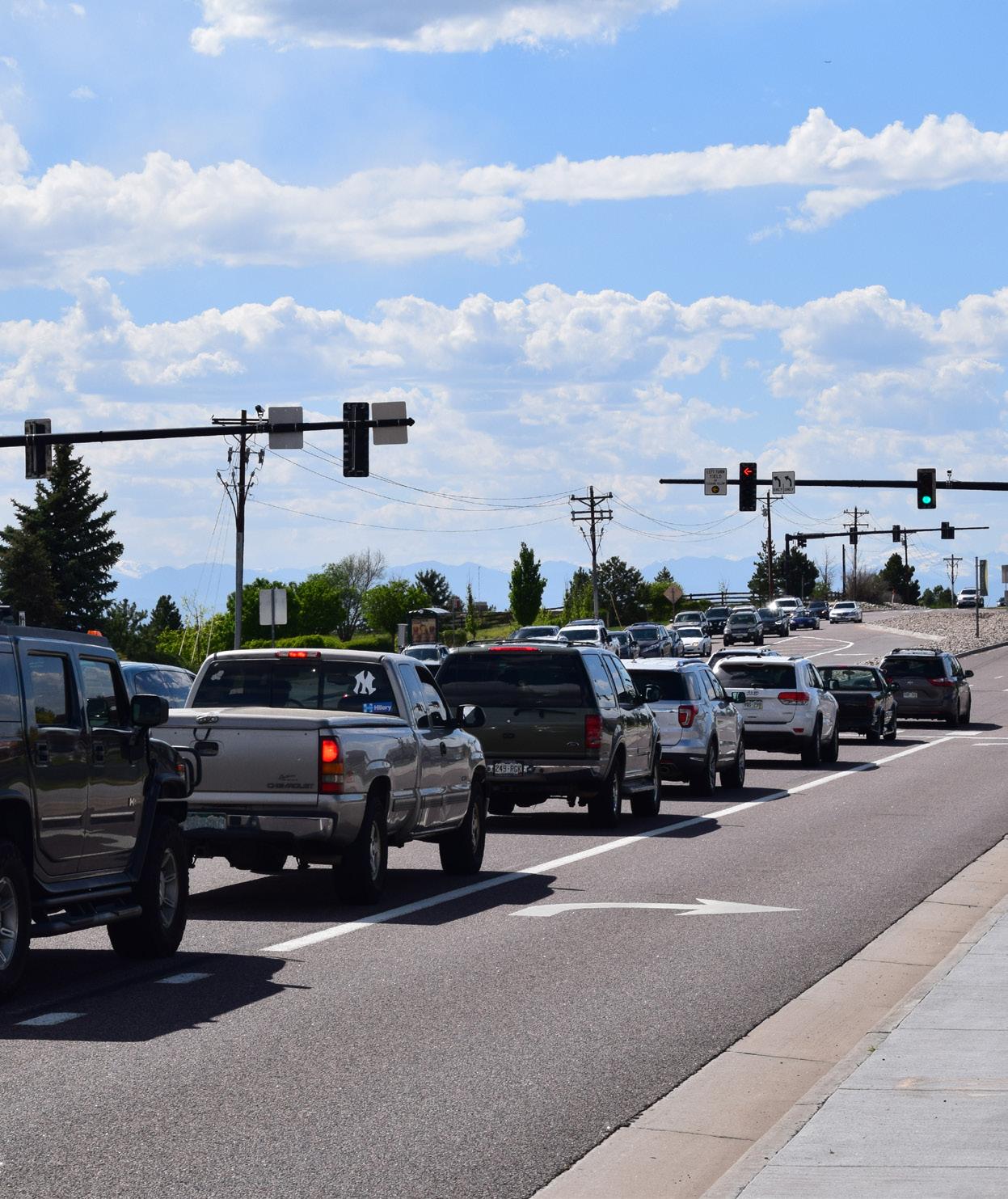

The Street Rehabilitation Program includes pavement reconstruction, overlay, surface treatment and concrete repairs for streets identified throughout the City in the pavement management program.

• The most recent pavement condition survey indicated the overall pavement condition of the City’s street network remains in the “Good” category, City Council’s goal for the Street Rehabilitation Program. The budget increase to $12 million for two years is necessary to account for the inflationary rise in material and labor costs in asphalt and concrete and continue to preserve the pavement network at the “Good” pavement condition.
Infrastructure projects, like the Street Rehabilitation Program, result in safer roadways, bridges and traffic systems for pedestrians and motorists.
The Roadside Improvement Program provides funding for the installation of cobble along the roadside to improve aesthetics and reduce ongoing maintenance requirements, such as weeding and watering. Council previously funded a pilot program for the improvement of several roadsides across the City. This included portions of roadside adjacent to Arapahoe Road and Dry Creek Boulevard, as well as East Chenango Drive and South Himalaya Street. Through 2022, total spending from this pilot program was approximately $2,300,000.
Recommendations for the projects to be included in the 2023 Roadside Improvement Program are still being formulated and will be presented at a City Council meeting in 2023.
Roadside improvements help enhance the City’s aesthetics, ensuring Centennial is a desirable place to live, work and play.


This program adheres to CDOT bridge inspection reports to define, design, repair and maintain bridges throughout the City.
Infrastructure projects, like the bridge maintenance and repair, result in safer roadways, bridges and traffic systems for pedestrians and motorists.
This program provides funds to address high-priority maintenance and repairs of City infrastructure like retaining walls, fences and guard rails.
Infrastructure projects, like the maintenance and repair of minor structures, result in safer roadways, bridges and traffic systems for pedestrians and motorists.

Roadway Improvements includes projects like building new roads and turn lanes, and enhancements to pedestrian and cycling infrastructure, utilities, pavement, drainage facilities or other structures or improvements within the right-of-way.
Roadway improvements planned for 2023-2024:
• Dry Creek Road, from Chester Street to Inverness Drive East ($400,000)
• Broncos Parkway at Tagawa Road ($605,000)
• Colorado Boulevard from Dry Creek Road to Arapahoe Road ($250,000)
• Havana Street at Easter Avenue ($1,000,000)
Roadway Improvements can reduce delays and correct inefficiencies that occur in traffic systems, resulting in a safer transportation network for both pedestrians and motorists.
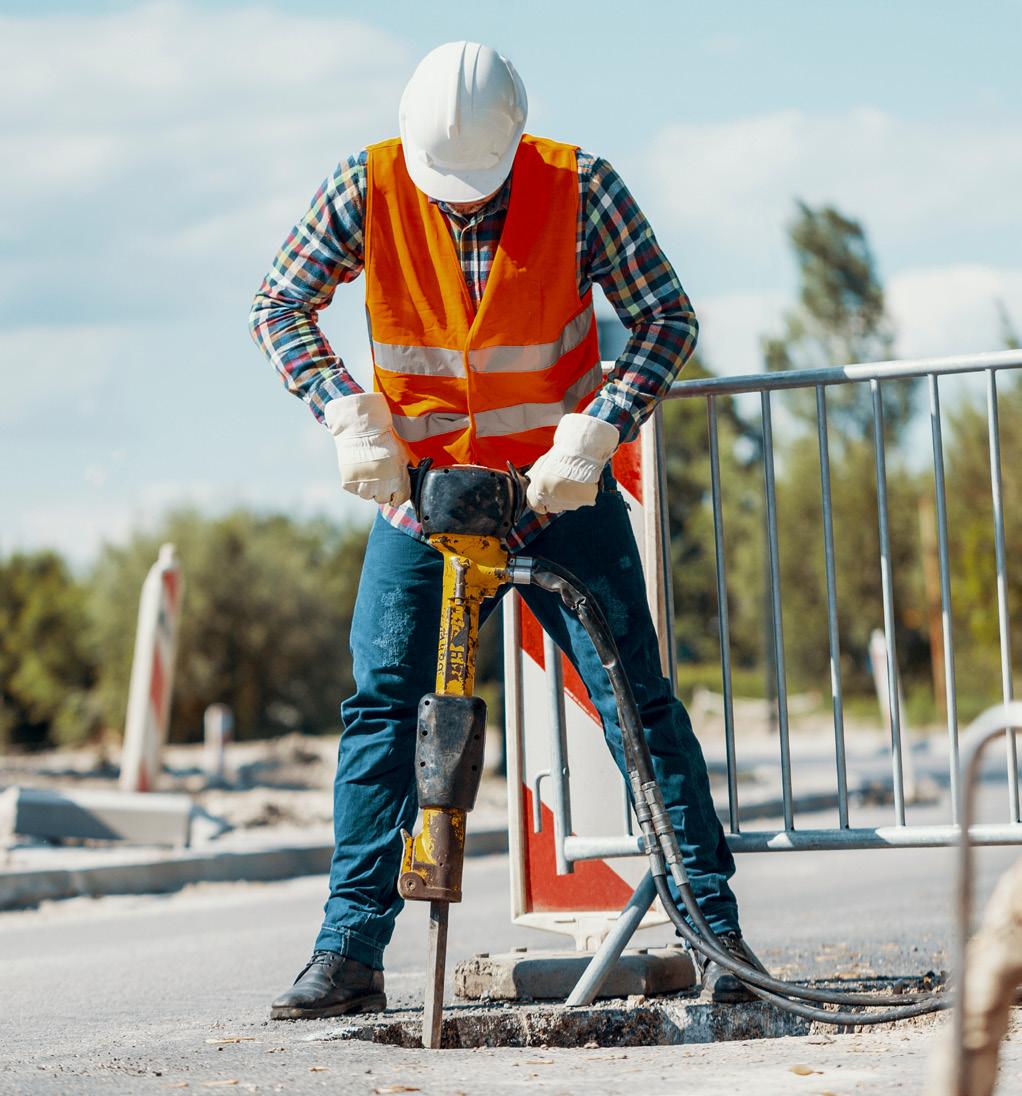
This project will widen the bridge to seven lanes (three lanes in both directions) and add an extended southbound turn lane for the intersection west of the bridge location at University Boulevard.
A contribution from the Open Space Fund will go toward construction of ADA-accessible paths that connect the Arapahoe Road sidewalk to the Big Dry Creek Trail. Xcel power lines also are planned for undergrounding prior to bridge construction.
The bridge project will provide accessibility to City trail networks and improve connectivity of the City’s pedestrian and motorist networks.

Douglas County is leading the effort for the County Line Road widening project, which will complete the last segment of County Line Road that needs to be widened from two to four through lanes for complete reconstruction. This project also will include a new traffic signal at the Clarkson Street/County Line Road intersection. The City’s funds will contribute toward the construction of the road widening.
The reconstruction and widening of the road has several goals, including adding roadway capacity, improving safety and drainage on the road, adding sidewalks and traffic lights and mitigating roadway noise for nearby residents.
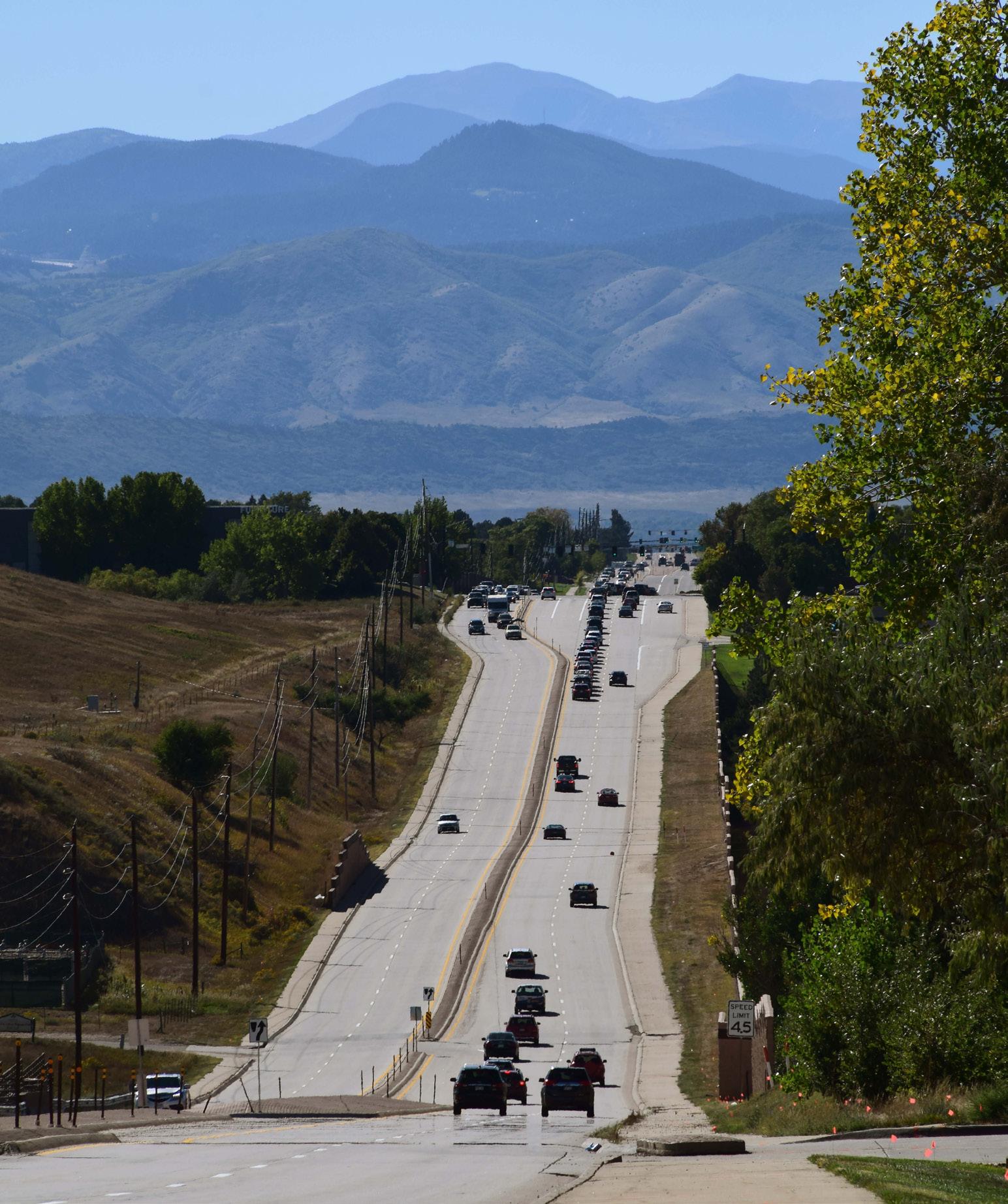
The Neighborhood Traffic Management Program addresses City-wide neighborhood traffic management improvement opportunities.
The program’s primary objectives are to improve traffic safety on neighborhood streets and foster pedestrian safety through citizen involvement and efficient allocation of public resources.
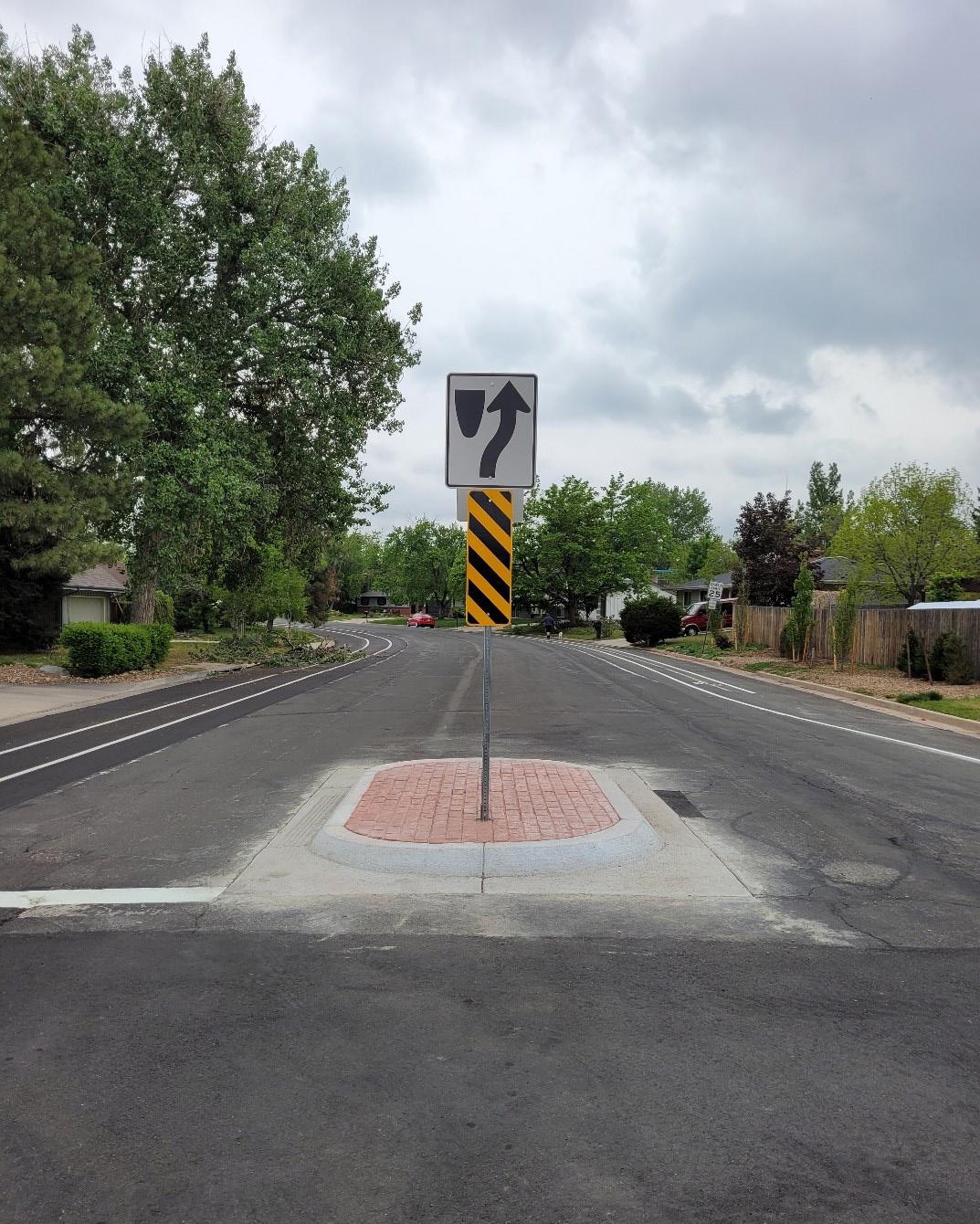
The installation of new traffic signals includes funding for signals at intersections that meet City warrants and requirements. The budget also includes funding for creating additional fiber-optic backbone connections throughout the fiscal year.
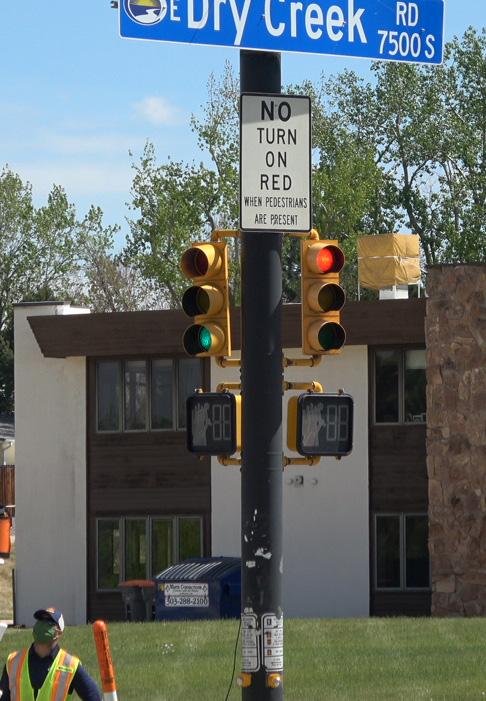
2023 anticipated projects ($3,858,000):
• Easter and Kenton ($800,000)
• Arapahoe and Clarkson - DRCOG Safer Main Streets ($500,000)
• Holly Street HAWK (Pedestrian Hybrid Beacon) SignalDRCOG Safer Main Streets ($313,000)
• Arapahoe and Forest, Arapahoe and Heritage Place Spanwire Replacement ($1,300,000)
• East Dry Creek Road and Inverness Drive East, East Dry Creek Road and Inverness Boulevard Design ($160,000)
• Continue implementation of flashing yellow arrow upgrades ($75,000)
• Begin installing uninterruptable power supplies at intersections ($200,000)
Improved traffic signals can reduce delays and correct inefficiencies that occur in traffic systems, resulting in a safer transportation network for both pedestrians and motorists.
Each year, City Council approves several sidewalk projects, totaling more than one mile of new pedestrian access. The following projects have been identified for 2023-2024:

• Infill sidewalk program ($75,000)
• Holly Street near Arapahoe Road ($250,000)
• Alton Way from Alton Court Street to Yosemite Street ($83,000)
• Alton Court from Alton Way to Dry Creek Road ($125,000)
• Otero Avenue from Newport Way to church property ($65,000)
• Niagara Street from Newport Way to Newport Court ($66,000)
• Easter Avenue west of Havana Street ($27,000)
As part of the Strategic Plan, City Council identified improvements to pedestrian safety and mobility, including the construction of additional sidewalks throughout the City. These projects will help to improve connectivity and accessibility across the City’s pedestrian network.
This project covers the design and land acquisition costs for the proposed Arapahoe Road side paths project from I-25 to Parker Road. The project would construct multimodal side paths to fill in gaps in existing sidewalk. ADA-compliant curb ramps would be provided or upgraded, and improvements in access to transit facilities are anticipated.
The project is being funded through a DRCOG grant in the amount of $4,479,000. Centennial’s grant match is $425,000. Greenwood Village is contributing $25,000.
As part of the Strategic Plan, City Council identified improvements to pedestrian safety and mobility, including the construction of additional sidewalks throughout the City. These projects will help to improve connectivity and accessibility across the City’s pedestrian network.

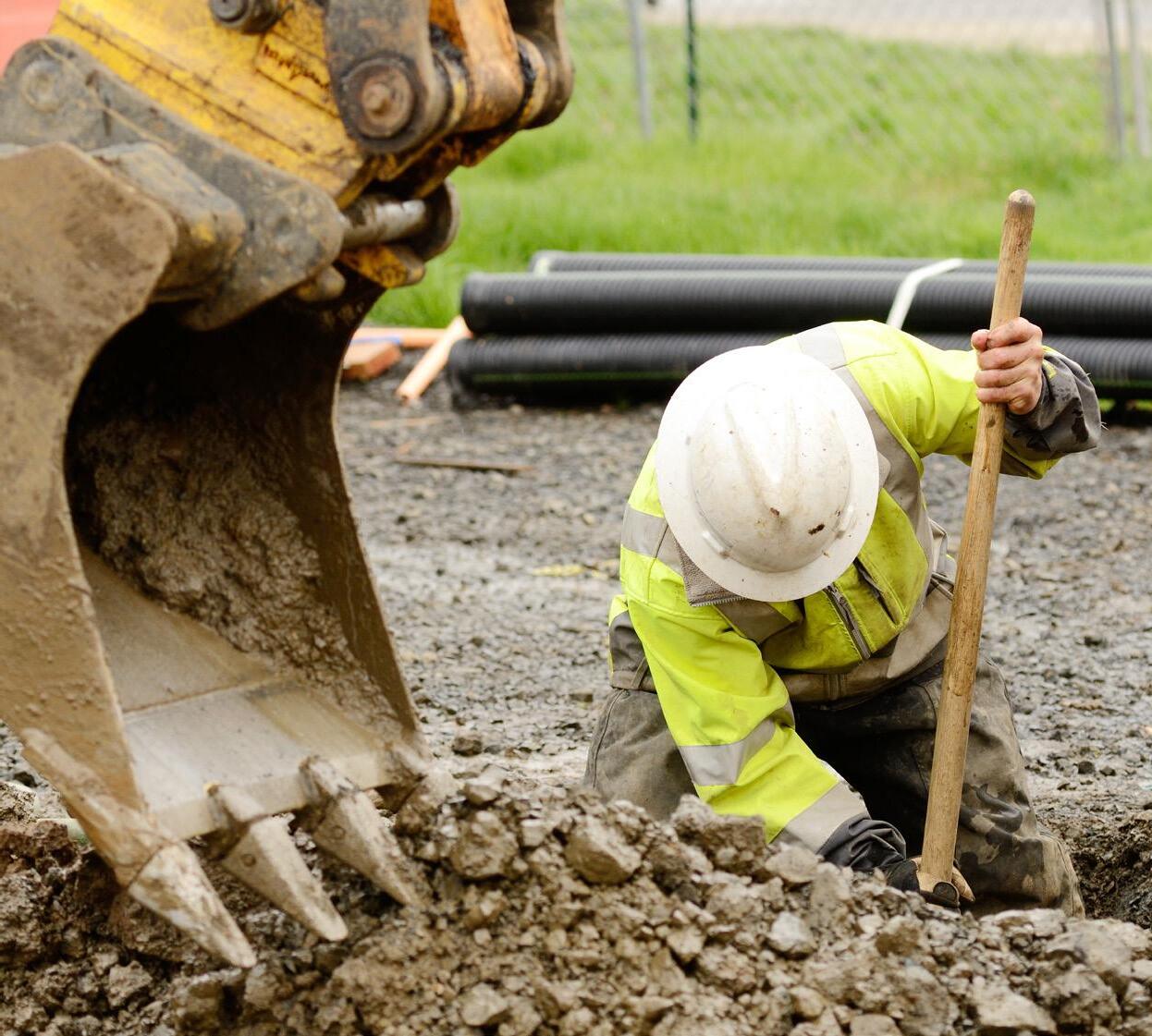
This project will result in the repair and enhancement of structural components, mechanical and electrical systems, plumbing and other vital systems to the Civic Center and Eagle Street facilities.
The following projects have been identified for 2023:
• Skylight work (Civic Center)
• Electric vehicle charging stations (Civic Center/Eagle Street)
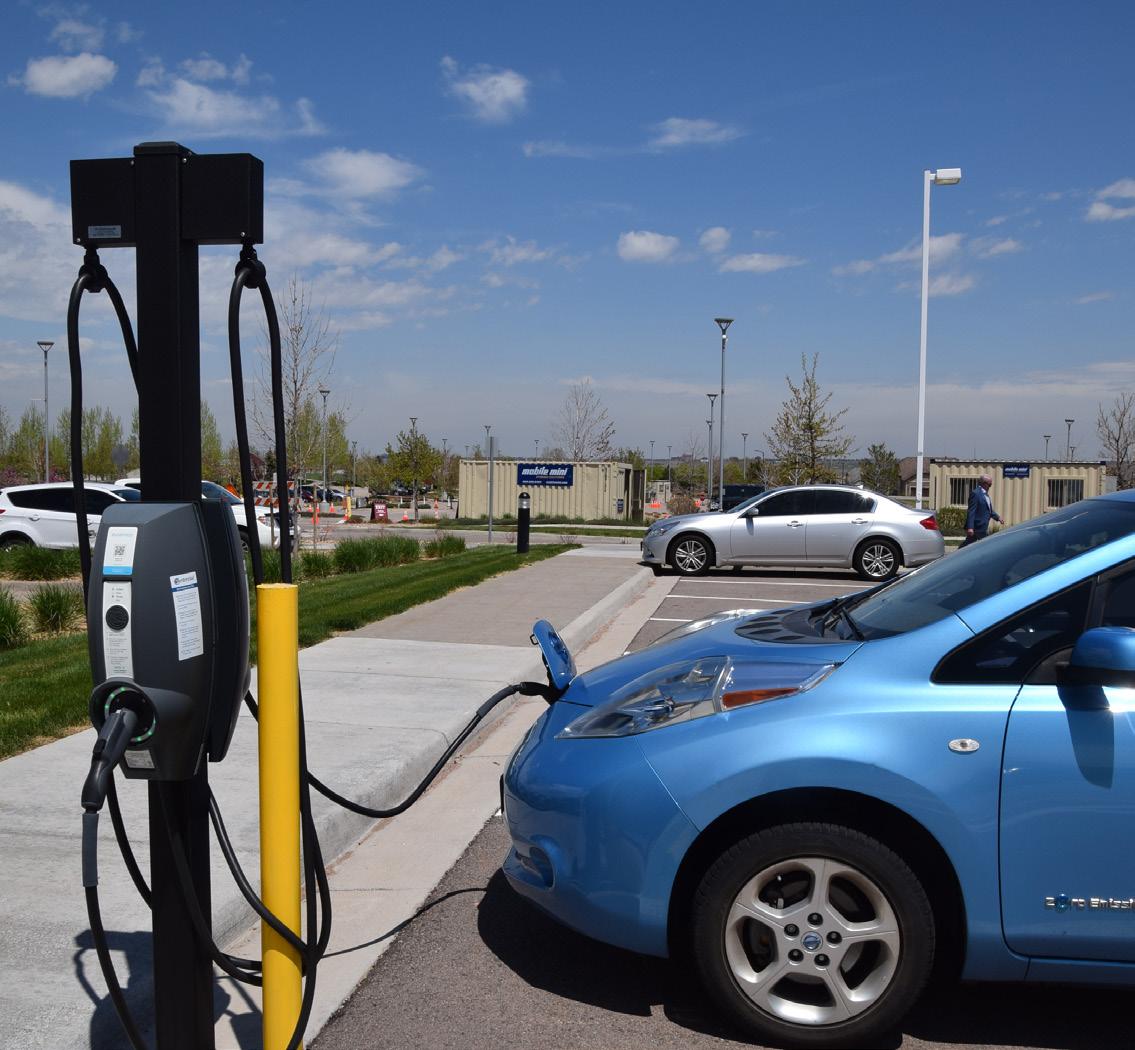
• Eagle Street retaining wall
• Eagle Street Phase 1 asphalt work
• Eagle Street Jordan Road slope remediation
The maintenance, repair and upgrade of City assets can help to prevent long-term and costly repairs in future years.
This project continues to focus on Intelligent Traffic System design and implementation throughout the City. The planned work included in this Budget Highlight includes:
• Continued ITS fiber and construction support
• Advanced and stopbar detection
• Completion of adaptive system
• Installation of weather stations to support traffic and snow and ice operations
Improvements to the ITS system can reduce delays and correct inefficiencies that occur in traffic systems, resulting in a safer transportation network for both pedestrians and motorists.

Construction of an eight-foot-wide crusher fines trail from East Caley Avenue into the Cherry Creek State Park. The proposed trail will require two channel crossings, one at Lone Tree Creek and one at Windmill Creek. This phase also includes Lone Tree Creek channel improvements within the State Park where the creek has developed a new flow path due to erosion.
Implementation of approved multi-phase Lone Tree Creek Trail project:

• The City entered into an intergovernmental agreement with Arapahoe County where the City will receive $4,500,000 from the County for implementation of Phases I-III.
• This implements the 2017 Trails and Recreation Plan
Priority T3: Aligned with the Arapahoe County Bicycle and Pedestrian Master Plan, prioritize construction of off-street trails in Centennial (T3.1 - Lone Tree Creek Trail - District 3).

The trail will connect east to the Cherry Creek Regional Trail with the completion of Phase II. Due to increased costs an additional $50,000 within the Open Space Fund (totaling $200,00) and an additional $10,000 (totaling $50,000) within the Street Fund is included, for a total project budget of $250,000.
This project implements the 2017 Trails and Recreation Plan
Priority T3: Aligned with the Arapahoe County Bicycle and Pedestrian Master Plan, prioritize construction of off-street trails in Centennial.
Pedestrian safety and mobility continue to be a priority for City Council, and these projects support this vision by improving connectivity and safe accessibility across the City’s pedestrian network.
Pedestrian safety and mobility continue to be a priority for City Council, and these projects support this vision by improving connectivity and safe accessibility across the City’s pedestrian network.
This funding will complete the construction of Phase I of the East Fremont Trail between the Lone Tree Creek Trail and South Jordan Road. The trail will eventually connect east to the Cherry Creek Regional Trail with the completion of Phase II.

This project implements the 2017 Trails and Recreation Plan Priority T3: Aligned with the Arapahoe County Bicycle and Pedestrian Master Plan, prioritize construction of off-street trails in Centennial.
This is a joint project with Open Space and Street Funds ($200,000 Open Space Fund and $50,000 Street Fund).
Pedestrian safety and mobility continue to be a priority for City Council, and these projects support this vision by improving connectivity and safe accessibility across the City’s pedestrian network.
The Centennial Link Trail is a 16-mile trail that traverses the entire width of the City of Centennial. There are several offstreet segments of trail that need to be constructed and other segments that require widening. On-street work includes striping. Signage and wayfinding costs also are included within the project.
Trail segments to be addressed with current and future funding include:
• Segment 14 Construction – District 4 – 2023 ($400,000) Piney Creek Trail from South Tower Road from Lake Avenue to East Orchard Road - This Segment is located near Piney Creek Hollow Park and runs from South Tower Road from Lake Avenue to East Orchard Road.
• Segment 10 Construction – District 3 – 2024 ($220,000) This segment is located north of East Caley Avenue near the intersection of East Caley Avenue and South Lima Street. The trail connection will run north and south and will connect to the existing Cottonwood Creek Trail just west of the Cottonwood Creek pedestrian bridge at South Peoria Street.
• Segment 5 Construction – District 2 – 2024 ($485,000)This segment is located along the south side of Cherry Park Trail from Krameria Way to Caley Avenue. The trail connection will be 10 feet wide, with striping/signage for two minor street crossings at Weaver Avenue and Caley Avenue.
These missing links in the trail network will provide access to eastern Centennial, connecting to neighborhoods, parks and trails, including the Cherry Creek State Park, Cherry Creek Trail and Lone Tree Creek Trail.
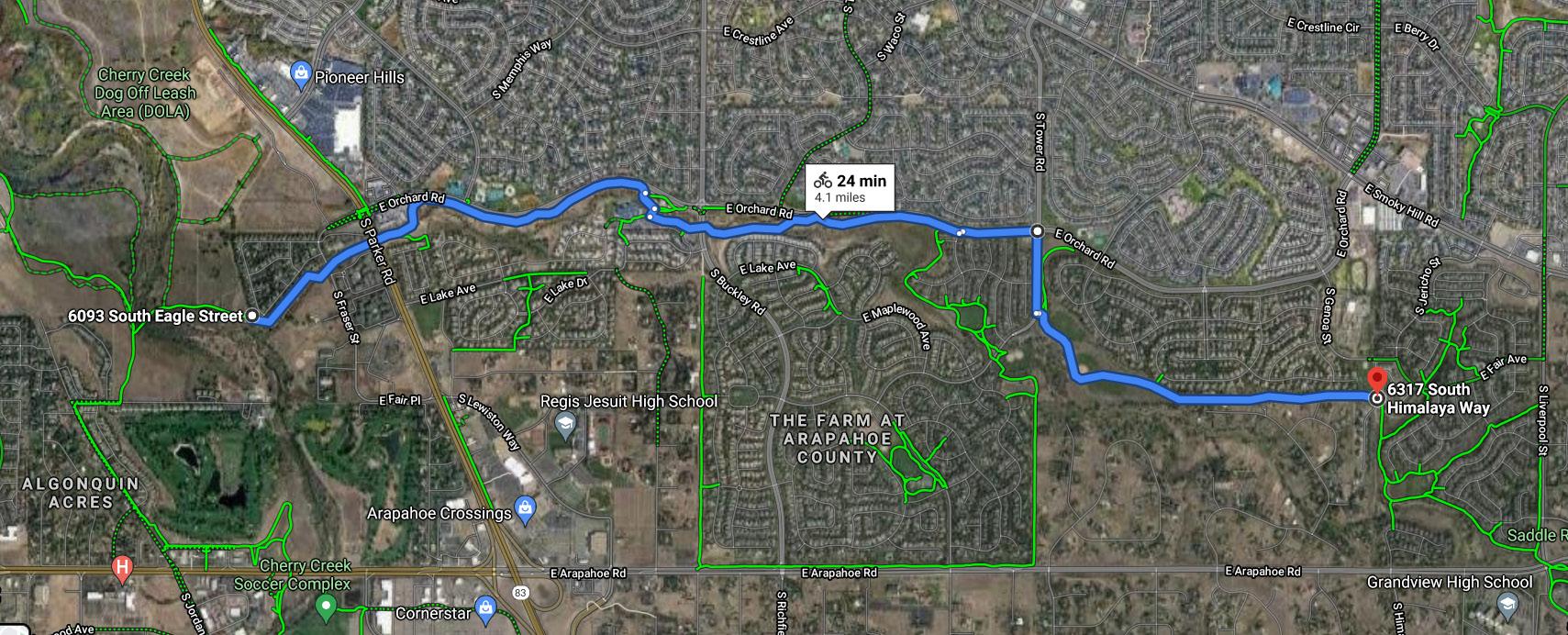
This project implements the 2017 Trails and Recreation Plan Priority T1: Complete a Centennial-branded continuous eastwest trail connection across the City, and Priority T2: Work with regional partners to connect existing trails to provide continuous east-west connections between the E-470 trail and the South Platte River Trail and north-south connections from the E-470 and C-470 trails through Centennial.
Pedestrian safety and mobility continue to be a priority for City Council, and these projects support this vision by improving connectivity and safe accessibility across the City’s pedestrian network.

These improvements will include the widening of the trail in four specific locations (semi-blind areas) to promote a safer trail user experience, striping of the trail in these areas to promote safe lane use and the addition of a soft trail shoulder adjacent to the existing concrete trail. The soft trail will vary in width and location depending on the location of the existing concrete trail. It is anticipated that the addition of the soft trail feature may be phased over a two- to three-year period.
This project implements the 2017 Trails and Recreation Plan
Priority T1: Complete a Centennial-branded continuous east-west trail connection across the City; Priority T2: Work with regional partners to connect existing trails to provide continuous east-west connections between the E-470 trail and the South Platte River Trail and north-south connections from the E-470 and C-470 trails through Centennial; and Priority T3.1 Priority trail connections aligned with the Arapahoe County Bike and Pedestrian Plan include Piney Creek Trail widening.
Pedestrian safety and mobility continue to be a priority for City Council, these projects support this vision by improving connectivity and safe accessibility across the City’s pedestrian network.
Description: The project includes a playground expansion with new play structures, a new picnic area expansion/ enhancement, shade tree plantings with new irrigation enhancements and a new trail that creates a new formal access point that is ADA accessible.
This project is part of the 2023 Eligible Partner Projects and was recommended by the Open Space Advisory Board in June 2022. Total Project Costs: $243,325 ($182,500 Centennial-funded)
This project implements the 2017 Trails and Recreation Plan Priority P5: Identify desired upgrades to existing parks in partnership with park districts and community members, and Recommendation P5.5: Provide massed tree canopies with seating and provide shelter and places of rest and encourage lingering in parks.
Description: Planned improvements propose a tree risk assessment and an expanded tree planting project to the Centennial section of the Highline Canal Trail and the Centennial Link Trail. The tree planting project will engage volunteers to plant 100 new trees and irrigate those trees for three years. The risk assessment will evaluate the health of each tree on the Canal over 12 inches in diameter and identify dead or dying trees that pose a risk to trail users.
This project is part of the 2023 Eligible Partner Projects and was recommended by the Open Space Advisory Board in June 2022. Total Project Costs: $100,000 ($90,000 Centennial-funded)
This project implements the 2017 Trails and Recreation Plan Priority P5: Identify desired upgrades to existing parks in partnership with park districts and community members, and Recommendation P5.5: Provide massed tree canopies with seating and provide shelter and places of rest and encourage lingering in parks.
Description: The Abbott Park Improvement Project proposes updates to the playground equipment and surfacing, basketball court, benches, concrete walkways and handicap parking spaces. This project improves ADA access, makes necessary updates to park amenities and enriches recreational opportunities in the park for everyone. The existing shade pavilion, san-o-let enclosure, light pole, park signage and drinking fountain will remain.
This project is part of the 2023 Eligible Partner Projects and was recommended by the Open Space Advisory Board in June 2022. Total Project Costs: $716,000 ($358,000 Centennial-funded)
This project implements the 2017 Trails and Recreation Plan Priority P5: Identify desired upgrades to existing parks in partnership with park districts and community members, and Recommendation P5.5: Provide massed tree canopies with seating and provide shelter and places of rest and encourage lingering in parks.
Description: This project proposes a replacement of the playground area, basketball court, shade pavilion and seating and the installation of a san-o-let enclosure. Concrete walkways and playground surfacing will be upgraded to provide better accessibility within the core of the park. The proposed improvements benefit current and future users by making necessary updates to park equipment, developing functional park elements, improving ADA access and capacity and promoting recreational opportunities for all users.
This project is part of the 2023 Eligible Partner Projects and was recommended by the Open Space Advisory Board in June 2022. Total Project Cost: $676,000 ($338,000 Requested, $123,004 Centennial-funded)
This project implements the 2017 Trails and Recreation Plan Priority P5: Identify desired upgrades to existing parks in partnership with park districts and community members, and Recommendation P5.5: Provide massed tree canopies with seating and provide shelter and places of rest and encourage lingering in parks.